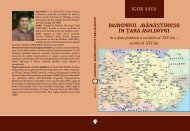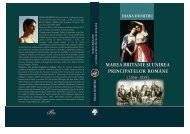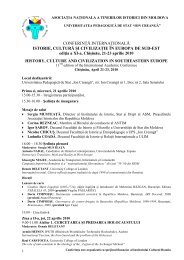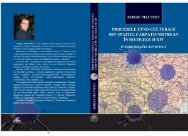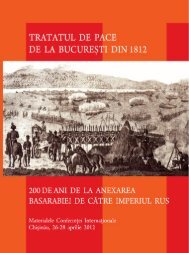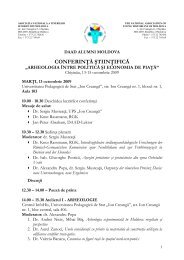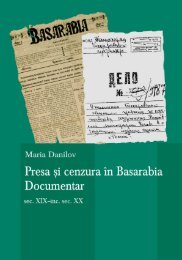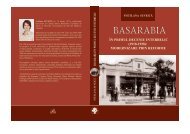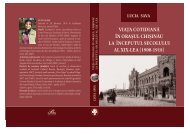Publicatie cu continut integral - Asociatia Tinerilor Istorici din Moldova
Publicatie cu continut integral - Asociatia Tinerilor Istorici din Moldova
Publicatie cu continut integral - Asociatia Tinerilor Istorici din Moldova
You also want an ePaper? Increase the reach of your titles
YUMPU automatically turns print PDFs into web optimized ePapers that Google loves.
latGale as lIeUX De MeMOIRe: re-tHınKınG Hıstorıes and constructınG<br />
ıdentıtıes ın natıonalıstıc ımaGınatıon 1<br />
– 0 –<br />
maksym W. KYRCzaniW<br />
Voronezh State University<br />
Modern Latgale, like Vidzeme, Kurzeme and Zemgale, is one of the Latvian regions. Latgale has it own history.<br />
Historical processes in this region were not like processes which took place in other Latvian territories. Contacts<br />
between local Balts and their Slavic neighbors led to changes in Latgale. That is why Latgale got unique features<br />
in language, <strong>cu</strong>lture and religious preferences of local Latvians. In the same time history of Latgale wasn’t part<br />
of Latvian history in general. Latgale belonged to Poland ant later, in the 19th century, it was part of Vitebskaia<br />
guberniia. Local Latgalian intellectuals were not among active Latvian nationalists.<br />
By the beginning of the 20th century among Latvians were many Latvian nationalists and Riga become the<br />
center of Latvian National Revival. Latgalian region didn’t play remarkable role as it did it during early political<br />
history of Latvia. In the same time Latgale was less developed territory then other lands. In general Latgale was<br />
backward region. It lived due the laws of «narrow provincialism», local political, <strong>cu</strong>ltural and national processes<br />
had ultra-local mainly regional, non Latvian, character. National leaders of non-Russian movements in other<br />
okraina regions and national outskirts in Russian Empire also often underlined such facts 2 . Latvian intellectual of<br />
the Soviet era L. Taivans presumed that Latgale was territory where old archaic <strong>cu</strong>lture dominated 3 . In Latgale,<br />
due theories of Regional Studies 4 , non-communicative identity developed. By the beginning of the 1900s important<br />
status of Latgale was in the past and the region was typical periphery 5 . German historian Hans Heinrich Nolte<br />
presumes that lands, like Latgale, were separated from other Latvian lands by political “failure” 6 . Sidney Pollard<br />
presumes that such un-developed lands existed in conditions of permanent provincialization of local political and<br />
<strong>cu</strong>ltural norms 7 .<br />
National Awaking begun here later, in the beginning of the 20th century, but after Russian revolution (1917)<br />
by 1920 Latvian intellectuals were able to unite Latgale with other Latvian lands. That is why, on political map of<br />
Europe latvijas republika, new state, appeared. In inter-war Latvia local Latgalian intellectuals got opportunities<br />
for development of their <strong>cu</strong>lture and language, but after political upheaval in 1934, when Kārlis ulmanis went to<br />
power, Latgalian was prohibited. When Latvia was oc<strong>cu</strong>pied by Germans in 1941 Latgalians again got opportunities<br />
for development of their <strong>cu</strong>lture, but Soviet re-oc<strong>cu</strong>pation in 1944/1945 led to restoration of anti-Latgalian<br />
policy. Latgale lost local unique features and transformed from region with status of periphery to part of Latvian<br />
SSR. Soviet ideologists proclaimed that Latgalians belonged to Latvian socialist nation.<br />
Latvian intellectuals begun to understand Medieval Latgale as local Latvian lieux de memoir only. Under lieux<br />
de memoir I understand as different historical phenomena like historiography, history of ideas (this viewpoint is<br />
characteristic mainly for French historiography) and geographically determined territories (this article is based on<br />
the second understan<strong>din</strong>g). Latvian historians, during soviet oc<strong>cu</strong>pation, also imagined Latgale in their own way,<br />
but as Latvian (not Latgalian) region. History of Medieval Latgale was artificially written in All-Latvian context.<br />
In the same time it was understandable in categories of social and economic history. National heritage was ignored<br />
and in historical concepts it was replaced by meta-narratives about ruling role of the Great Russian People or participation<br />
of Latgalian workers and peasants in class struggle or revolutionary movement. Latgalian intellectuals<br />
in diaspora continued to use Latgalian language and <strong>cu</strong>ltivated their own narratives about Latgale. In the Latvia<br />
1 I am thankful to Dr. Tuomas Lehtonen (Finnish Literature Society), prof. Thomas Lindkvist (Göteborg University), Alexander Andreeff<br />
(Gothenburg University), Eva Eihmane (University of Latvia), Marek Tamm (Tallinn University) for their interesting remarks which were<br />
very helpful for writing of this paper.<br />
2 DONTSOV, 2001, 72.<br />
3 TAIVAN, 1988, 21.<br />
4 DIKMANN, 2001, 74.<br />
DIKMANN, 2001, 74.<br />
5 NITTS, 2001, 32.<br />
6 NOL’TE, 2001, 51 – 61.<br />
7 POLLARD, POLLARD, 1995, 121 – 136.<br />
Analele ANTIM. Revistă de istorie, 8, 2008, p. 207-215



